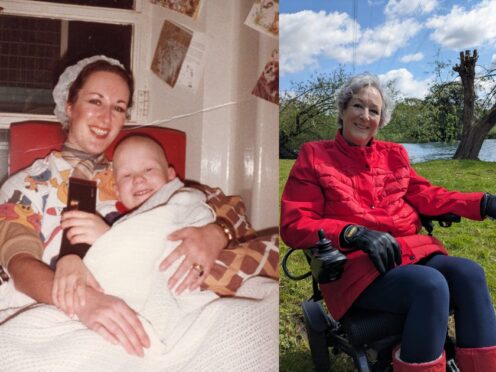Police have said they are “making enquiries” after a mother told how she gave her cancer-stricken son a dose of morphine she believes “did quietly end his life” more than 40 years ago.
Antonya Cooper’s son Hamish was five-years-old when he was diagnosed with stage 4 neuroblastoma – a rare childhood cancer – and aged seven when he died at home on December 1 1981.
Ms Cooper, a former chair of Neuroblastoma UK, who lives in Abingdon in Oxfordshire, said her young son had been “in a lot of pain” by the end of his life.
She told BBC Radio Oxford: “I gave him a large dose of morphine that did quietly end his life.”
Thames Valley Police said it was “aware of reports relating to an apparent case of assisted dying of a seven-year-old boy in 1981”.
The service added: “At this early stage, the force is making enquiries into these reports and is not in a position to comment further while these investigations continue.”
Speaking about her final moments with her son, Ms Cooper told PA Real Life in May: “In the middle of the night, we were by his bedside.

“He was expressing that he had pain and I said, ‘Would you like me to take the pain away?’
“He said, ‘Yes please, Mama’, and so I gave him a dose of morphine sulphate through his Hickman catheter.
“We had watched him brave through all that beastly treatment, we had had him for longer than the original prognosis, so the time was right.”
Euthanasia – deliberately ending a person’s life to relieve suffering – is illegal in England and could be prosecuted as murder or manslaughter.
As with all criminal offences, the Crown Prosecution Service (CPS) must follow the principles set out in the Code for Crown Prosecutors when deciding whether to start or continue a prosecution.
Ms Cooper, who is now living with her own incurable cancer and has joined assisted dying clinic Dignitas, was asked by the BBC if she understood she was potentially admitting to manslaughter or murder and replied: “Yes.”
She told the radio programme: “If they come 43 years after I have allowed Hamish to die peacefully, then I would have to face the consequences. But they would have to be quick, because I’m dying too.”
The conversation around assisted dying and calls for a change in the law has become louder in recent months, with legislation being considered in Scotland, the Isle of Man and Jersey.

Famous faces such as broadcaster Jonathan Dimbleby, who has previously described the current law as “increasingly unbearable”, and presenter Dame Prue Leith, who called for “less pearl-clutching” and more constructive conversation on the issue, have spoken out on the subject.
In December, Dame Esther Rantzen – who has stage 4 lung cancer – revealed she had joined Dignitas.
The Childline founder and broadcaster has called for a free vote on assisted dying in Parliament.
Campaigners opposed to a change in the law have voiced concerns that legalising assisted dying could put pressure on vulnerable people to end their lives for fear of being a burden on others, and argue the disabled, elderly, sick or depressed could be especially at risk.
